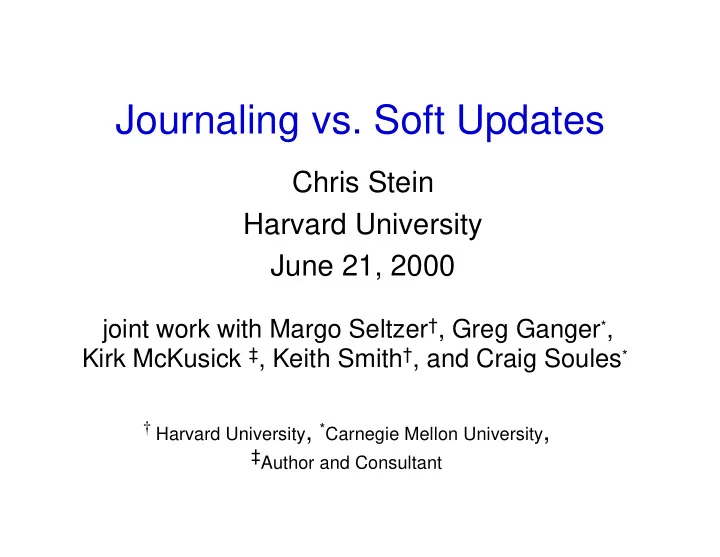

Journaling vs. Soft Updates Chris Stein Harvard University June 21, 2000 joint work with Margo Seltzer † , Greg Ganger * , Kirk McKusick ‡ , Keith Smith † , and Craig Soules * † Harvard University , * Carnegie Mellon University , ‡ Author and Consultant
Talk Outline • The Problem: – Meta-data consistency in file systems • Two solutions: – Journaling and Soft Updates • Evaluation • Conclusions
Meta-Data Update Problem • The file system meta-data contains inodes, directory blocks, and allocation bitmaps with interdependencies that must be cared for during disk updates. Block containing Directory block Inode 51 … Memory motd 51 write Disk inode 51 pointing to Top Secret File Disk
Approaches to Meta-Data Management • Synchronous Writes – FFS • Ordered Writes – Soft Updates • Logged Writes – Journaling
Properties of Meta-Data Ops • Integrity: – The file system is always recoverable. • Durability: – Updates are persistent once the call returns. • Atomicity: – No partial meta-data operations are visible after recovery.
Soft Updates Overview • Implementation: – Delayed meta-data writes. – Kernel maintains dependency information and uses it to order writes. • Properties: – Meta-data operations are not durable or atomic. – Looser guarantees than FFS about when updates will reach disk. – No recovery necessary after a crash.
Journaling Overview • Implementation: – Log logical meta-data operations. – Write meta-data in-place asynchronously. – Write-ahead logging (WAL) protocol guarantees recoverability. • Properties: – Log is scanned for recovery. – Meta-data operations are atomic. – Durability can be toggled on/off.
Feature Comparison Durability Atomicity Recovery Integrity fsck disk scan (minutes) FFS X X log-based (seconds) Sync Journaling X X X log-based (seconds) Async Journaling X X immediate Soft Updates X may be impossible FFS-async
Experimental Setup • Software: – Modified FreeBSD kernel. Taken from the current tree on Jan. 26 th , 2000. – 2 journaling file system implementations (LFFS-WAFS, LFFS-file). • Hardware: – 500 MHz Xeon Pentium III – 512 MB RAM – 3 x 9GB 10,000 RPM Seagate Cheetahs
Microbenchmarks • Create, Write, Read, Delete. • Results – Read/write performance identical for all systems. – All async systems have similar create throughput. – Soft Updates has great delete performance due to its ability to background work.
Macrobenchmarks • SSH-build – Unpacks, configures, and builds ssh. • NetNews – Simulates the work of a news server. • SDET – Emulates user interactive software development workload. • PostMark – Designed to model the workload seen by ISPs under heavy load. Combination of e-mail, news, and e-commerce transactions.
NetNews • Simulates the work of a news server. • Tremendous load, both in terms of the amount of data and the number of meta-data operations.
NetNews: Results Throughput Relative to FFS-async 1.2 1 0.8 0.6 0.4 0.2 0 Soft Updates Journaling FFS
PostMark • Designed to model the workload seen by ISPs under heavy load. • Simulates a combination of e-mail, news, and e-commerce transactions. • Different results for small and large file sets.
PostMark: Results Throughput Relative to FFS-async 1.2 1 0.8 0.6 0.4 0.2 0 Soft Updates Journaling FFS
Conclusions • Durability is expensive, integrity need not be. • Configuration changes can have a significant impact on performance, with no change in features.
Recommend
More recommend